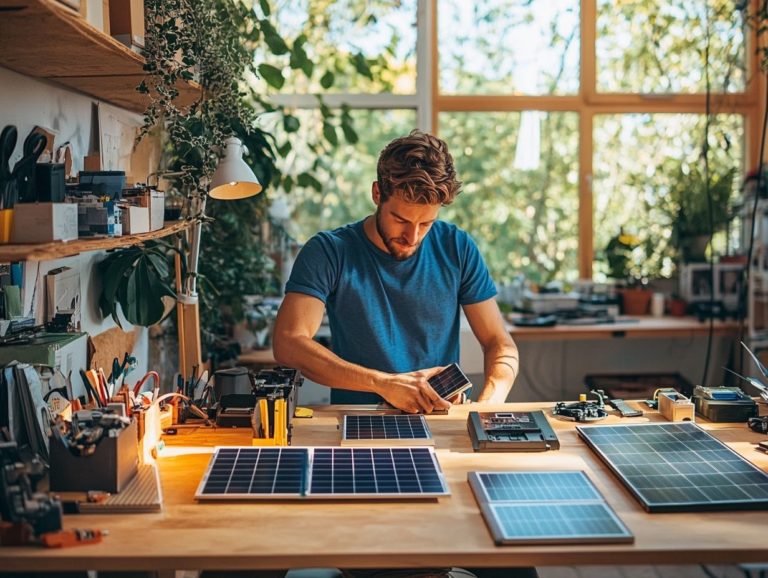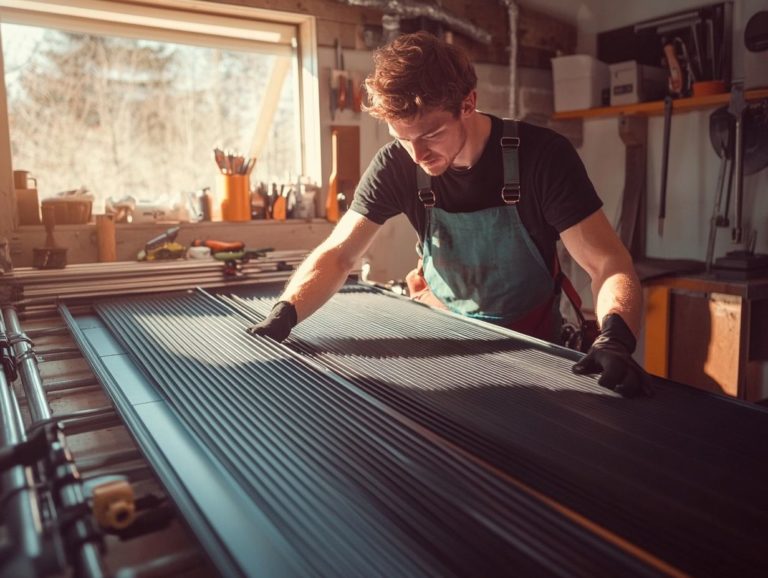5 Simple DIY Projects for Sustainable Energy Use
Sustainable energy and energy reduction projects have never been more crucial. This article explores five simple yet impactful projects that enable you to generate your own energy while minimizing waste at home.
You can create your own solar panel or set up a rainwater collection system. These projects not only help you save money on energy bills but also play a vital role in fostering a greener planet.
Uncover the benefits, gather the necessary materials, and learn how each project can effectively reduce your carbon footprint and energy use. Step into a world of sustainability where it is accessible and enjoyable!
Contents
- Key Takeaways:
- 1. Build Your Own Solar Panel
- 2. Create a Wind Turbine from Scrap Materials
- 3. Construct a Solar Water Heater
- 4. Make Your Own Compost Bin for Natural Fertilizer
- 5. Build a Rainwater Collection System
- Why Should We Consider Using Sustainable Energy?
- Frequently Asked Questions
- What are 5 simple DIY projects for sustainable energy use?
- Why is sustainable energy use important?
- What are the benefits of using DIY energy projects for sustainable energy?
- How can I determine which DIY projects are best for my home?
- Are there any safety concerns with DIY projects for sustainable energy use?
- Can I still make a difference with just 5 simple DIY projects?
Key Takeaways:
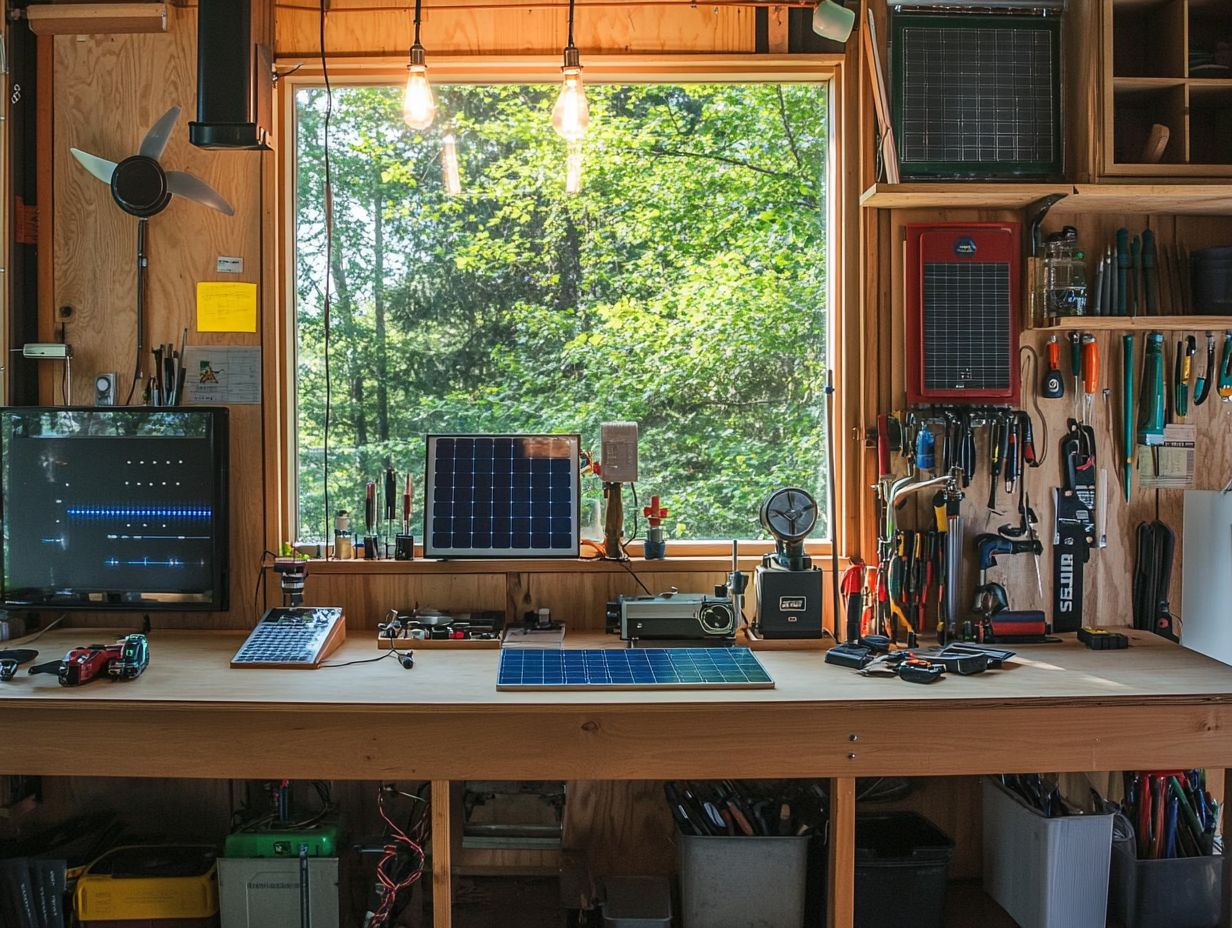
- Building your own solar panel can significantly reduce your reliance on traditional energy sources and save you money in the long run, while enhancing your home s energy efficiency.
- Creating a wind turbine from scrap materials is a fun and creative way to generate renewable energy and reduce your carbon footprint, contributing to energy independence (being less reliant on outside energy sources).
- Constructing a solar water heater can provide hot water using sustainable energy, reducing your energy bills and contributing to a greener environment with lower greenhouse gas emissions.
1. Build Your Own Solar Panel
Ready to save money and help the planet? Building your own solar panel is a fun project that cuts your energy bills and your carbon footprint!
To embark on this journey, start by sourcing high-quality materials, including solar cells, glass, and a sturdy frame. Understanding how each component functions is key. Solar cells are your power converters, transforming sunlight into electricity, while the frame provides the necessary structural support for an efficient energy prototype.
Once you ve gathered your materials, the construction process kicks off with assembling the solar cells in a grid configuration. Ensure they re connected correctly to optimize energy output and power management. After your panel is assembled, careful installation is crucial positioning it at the optimal angle to capture maximum sunlight throughout the day.
By harnessing solar energy, you’ll enjoy substantial savings on your energy bills and play a pivotal role in reducing greenhouse gas emissions and energy consumption. Together, we can pave the way for a cleaner, greener planet for future generations.
2. Create a Wind Turbine from Scrap Materials
Creating a wind turbine from scrap materials presents an innovative DIY project that empowers you to harness renewable energy while significantly cutting down your energy consumption.
To embark on this exciting venture, you’ll need a few essential materials:
- PVC pipes for crafting the blades
- A bicycle wheel to serve as the rotor
- A sturdy wooden post to construct the tower
- A generator that will convert the wind’s kinetic energy into electricity
The assembly process is straightforward. Begin by attaching the blades to the rotor, then secure the rotor atop the post, and connect the generator to a battery system for energy storage.
With just a few hours of effort, you can generate enough energy to power small appliances, resulting in lower electricity bills. Start your sustainable journey today and inspire others to join you!
3. Construct a Solar Water Heater
Constructing a solar water heater is an exciting way to boost your home s energy efficiency today! This DIY project not only trims your energy bills but also helps reduce greenhouse gas emissions and overall energy use.
This innovative system typically includes solar collectors, a storage tank, and a system that moves water through pipes. The solar collectors, often stylishly mounted on your roof, absorb sunlight and convert it into heat. This heat warms the water circulating through the thoughtfully placed pipes. As you embark on this construction journey, you’ll need to select the right materials and ensure optimal positioning to capture the sun’s rays effectively.
Once your solar water heater is up and running, it harnesses the warmth gathered to heat your potable water. This leads to a significant reduction in electricity or gas usage. The result is a noticeable dip in your energy costs and a commendable decrease in your carbon footprint, making this a responsible and rewarding choice for anyone looking to embrace eco-conscious living.
4. Make Your Own Compost Bin for Natural Fertilizer

Creating your own compost bin is an easy and rewarding DIY project that makes a real difference! By recycling organic waste, you can produce natural fertilizer for your garden while conserving energy and minimizing your environmental footprint.
To start this journey, gather a variety of materials. Think kitchen scraps like fruit and vegetable peels, yard waste such as grass clippings and leaves, and even cardboard or paper to balance those nitrogen-rich items. Consider insulating your compost bin to maintain an optimal temperature for decomposition.
The composting process is simple: layer these materials in your bin and let nature work its magic as they break down over time. This transformation turns waste into nutrient-rich compost, reducing your reliance on chemical fertilizers that can be detrimental to the environment. By opting for natural fertilizer, you not only nurture your plants’ growth but also embrace eco-friendly gardening practices that contribute positively to our planet.
5. Build a Rainwater Collection System
Building a rainwater collection system is not just a DIY project; it s a powerful step toward sustainable living! This initiative allows you to conserve water, reduce your reliance on municipal supplies, and embrace eco-friendly practices. This system can be a crucial part of your home improvement and energy transition strategy.
This system empowers you to collect and utilize rainwater efficiently while deepening your understanding of the local water cycle and its preservation. To create your own rainwater collection system, start by gathering the essential materials, which include:
- A rain barrel
- A downspout diverter (a device that directs rainwater from your roof into the barrel)
- A mesh screen to keep debris at bay
- A watering can or hose for easy access
The installation process is straightforward: attach the diverter to the downspout to direct the flow of water into the barrel. Regular maintenance, like cleaning the barrel and ensuring the screens remain unclogged, is crucial for maximizing the effectiveness of your system.
Ultimately, adopting this practice of water conservation significantly contributes to energy savings by reducing the demand on treatment plants, which expend considerable resources processing municipal water. Start building your rainwater collection system today and take a big step towards sustainability!
Why Should We Consider Using Sustainable Energy?
Considering sustainable energy is essential for your future. It significantly reduces your carbon footprint, fosters energy independence, and lowers greenhouse gas emissions. Additionally, it promotes energy efficiency and conservation practices such as sealing air leaks and duct insulation projects.
Transitioning to renewable sources like solar and wind can cut emissions by up to 70% by 2050. This paves the way for a healthier planet for generations to come. This shift not only contributes to environmental sustainability, but it also carries substantial economic benefits.
As you invest in clean energy technologies and energy efficiency tips, you ll find yourself relying less on fossil fuels which are energy sources like coal and oil and this helps stabilize energy prices while reducing vulnerability to international market fluctuations.
Studies indicate that investing in renewable energy can lead to job creation, with projections estimating over 24 million jobs worldwide in the sector by 2030. Embracing sustainable energy is a powerful move toward a brighter future! Energy rebates and incentives also make these investments more appealing.
What Are the Benefits of DIY Sustainable Energy Projects?
Engaging in DIY sustainable energy projects brings a wealth of benefits your way. You ll enjoy substantial energy savings and a reduced carbon footprint while enhancing your home s energy efficiency and overall energy performance.
When you take control of your energy consumption through personal innovation, you not only witness a significant drop in your utility bills, but you also make a positive contribution to the environment. For instance, consider a family that transformed their rooftop into a solar panel sanctuary; they halved their energy costs while generating clean energy.
This hands-on approach cultivates a profound sense of self-reliance. By diving into the world of energy alternatives, you ll feel more engaged and empowered in discussions about energy conservation.
These projects can also foster community spirit. Imagine collaborating with neighbors on initiatives or sharing resources and knowledge, creating a vibrant network that actively promotes sustainability. For example, organizing community events to install compact fluorescent light bulbs or caulking air leaks can lead to substantial electricity savings and reduced energy costs for everyone involved.
What Materials and Tools Will You Need for These Projects?
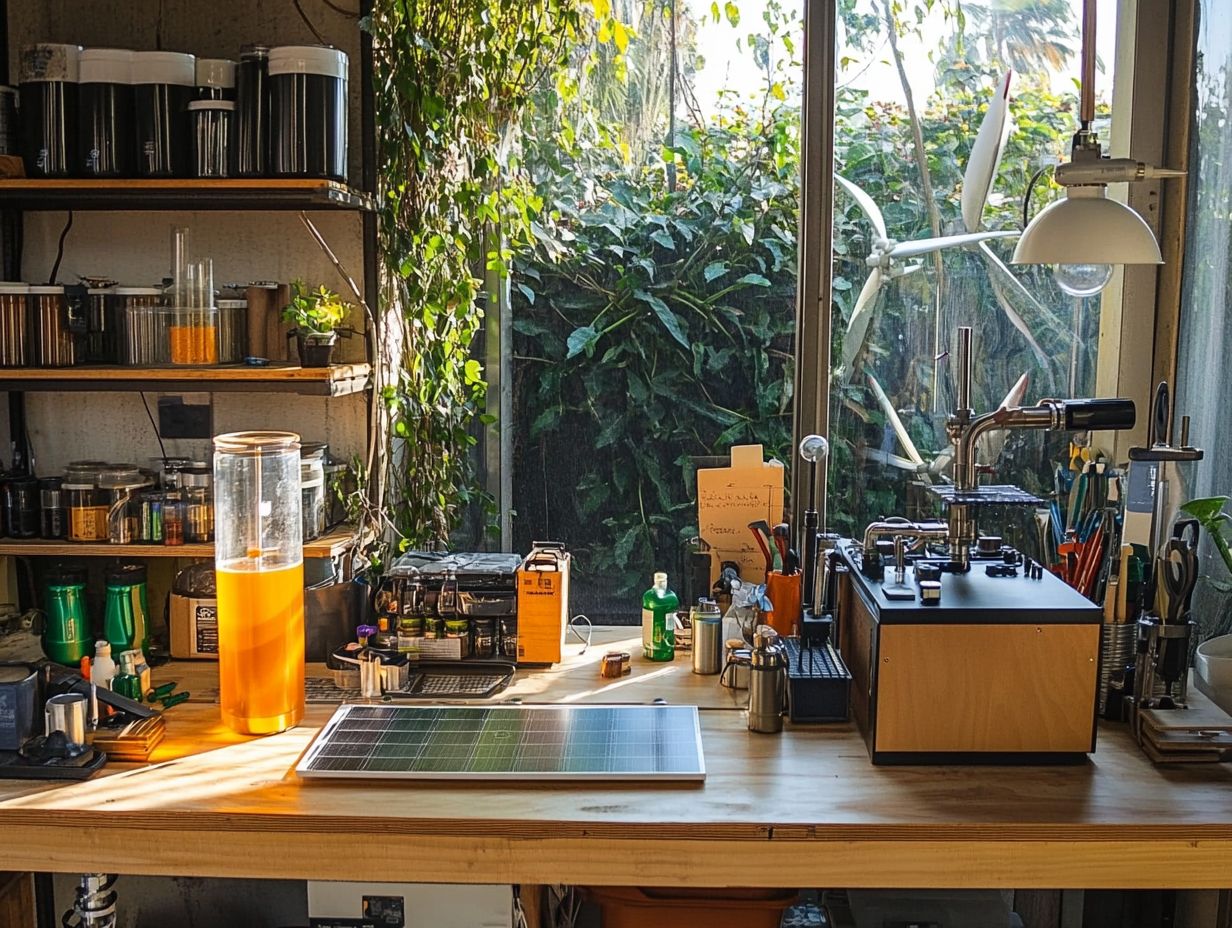
To embark on your DIY sustainable energy journey, gather a range of materials and tools that are accessible and budget-friendly. This ensures your foray into renewable energy and energy independence is both practical and economical.
Your projects could range from installing solar panels to constructing wind turbines or even setting up a simple rainwater harvesting system or a solar water heater. Each requires specific components tailored to the task at hand.
Common materials you might consider include:
- Solar cells
- Batteries
- Wiring
- Piping
- Duct insulation
As for tools, you’ll need a mix of essentials, from basic hand tools like screwdrivers and pliers to more specialized equipment such as soldering irons, multimeters, and a Kill-A-Watt meter. Local hardware stores usually offer great sourcing options at fair prices, but don t overlook online platforms or community exchanges for affordable alternatives.
If you’re keen to add a personal touch to your projects, think about customization options like vibrant paint for your solar panels or upcycled materials for your wind turbine blades. Not only can these choices enhance aesthetics, but they also amplify your positive environmental impact and contribute to sustainable living.
Start your DIY sustainable energy project today and be a change-maker in your community!
How Much Money Can You Save with These DIY Energy Projects?
Investing your time in DIY energy projects can lead to impressive savings on your energy bills and overall energy costs. Many homeowners experience reductions of up to 50% after implementing sustainable solutions.
Consider a family that took the plunge and installed their own solar panels. Initially, they might have spent around $15,000 on the project. However, with various incentives and tax credits, their actual out-of-pocket expense could be trimmed down to about $10,000. By making the switch to solar energy, they not only shield themselves from rising electricity costs but also save over $1,200 annually. This results in a remarkable return on investment in less than a decade.
Similarly, when you tackle insulation projects like caulking and duct insulation, the potential savings can be significant. A household that improves its insulation through DIY methods might invest around $2,000, yet see energy savings of roughly $400 each year. In this scenario, the project pays for itself within five years, showcasing how strategic energy initiatives can yield both financial and environmental rewards.
What Are Some Other Simple Ways to Use Sustainable Energy at Home?
Along with your DIY projects, you have a wealth of simple and effective options for incorporating sustainable energy into your home. These options elevate your energy efficiency and embrace a greener lifestyle.
For example, by implementing energy-efficient appliances, you can significantly cut down on electricity consumption. This not only lowers your utility bills but also minimizes your carbon footprint. Swapping out traditional incandescent bulbs for compact fluorescent light bulbs or other energy-efficient lighting solutions will not only reduce energy usage but also extend the lifespan of your lighting solutions.
Regular energy audits essentially a check-up for your home’s energy use can be a game-changer. These audits help you pinpoint areas of waste and identify potential improvements, such as sealing air leaks and enhancing power management. This makes it easier for you to make informed choices about your energy consumption.
Together, these practices empower you to play a meaningful role in energy conservation efforts, paving the way for a more sustainable future for generations to come.
How Can These Projects Help Reduce Your Carbon Footprint?
Implementing DIY energy projects can significantly diminish your carbon footprint by reducing greenhouse gas emissions and promoting energy savings through enhanced energy efficiency and reduction projects.
You might be surprised to learn that simple, hands-on modifications around your home can yield substantial environmental benefits. For example, a study from the U.S. Department of Energy reveals that unregulated home energy use contributes to approximately 25% of national greenhouse gas emissions. By taking the initiative to install DIY solar panels, a solar water heater, or improve your home’s insulation, you can dramatically lower your carbon footprint by cutting down nearly 1,000 pounds of carbon dioxide each year. Additionally, consider exploring 5 ways to reduce energy waste at home for more effective strategies.
Research shows that such projects can boost your household’s energy efficiency by up to 20%. This leads not only to lower utility bills but also to a decreased reliance on fossil fuels. You can enhance your energy independence by incorporating battery storage solutions, too.
These positive effects extend well beyond your home, playing a vital role in broader climate change mitigation efforts. They contribute significantly to the reduction of greenhouse gas emissions.
Frequently Asked Questions
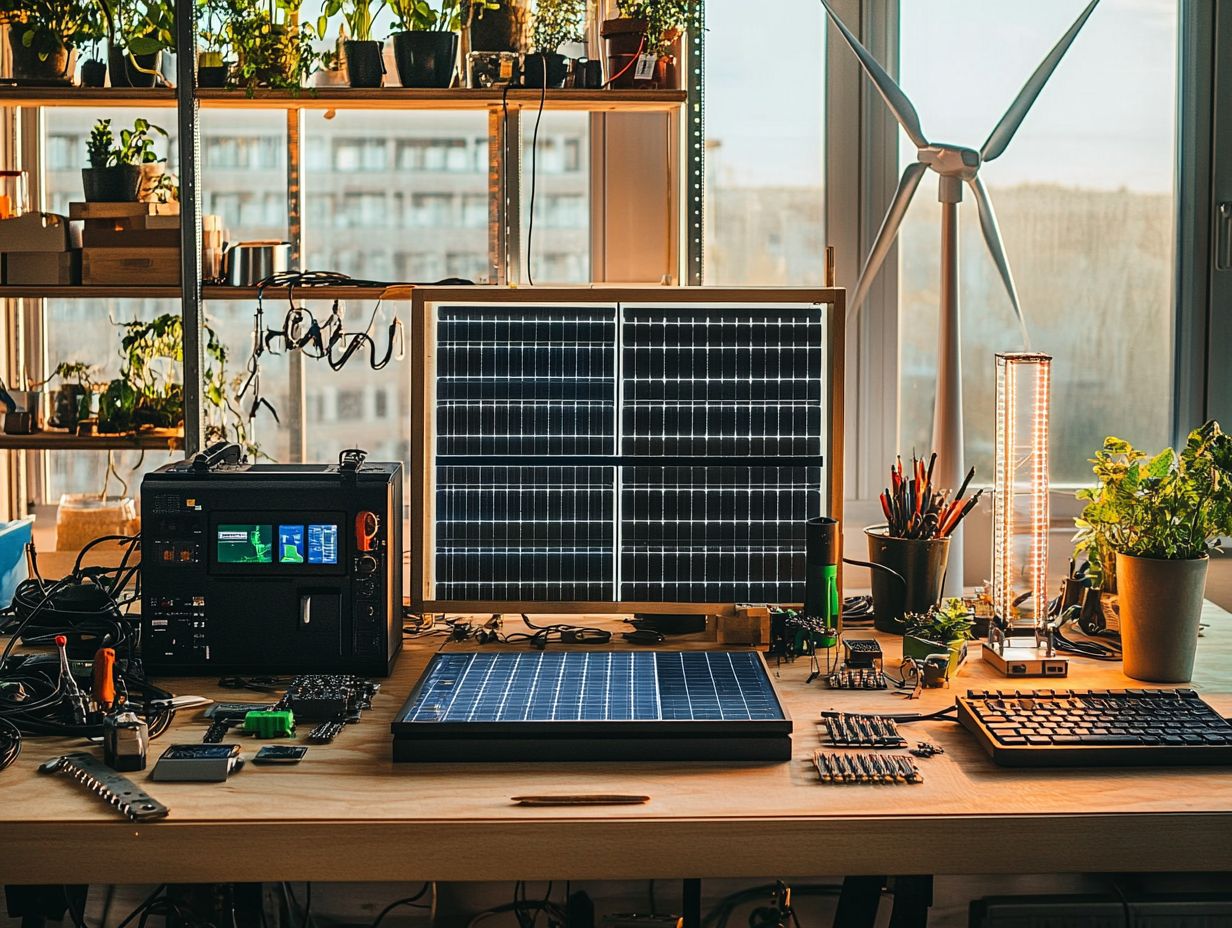
What are 5 simple DIY projects for sustainable energy use?
- Installing a programmable thermostat to save energy on heating and cooling.
- Installing low-flow showerheads and faucets to conserve water.
- Installing weather stripping and caulking around windows and doors to prevent energy loss.
- Creating a compost bin to reduce food waste and create natural fertilizer for your garden.
- Installing solar-powered outdoor lights for energy-efficient lighting.
Why is sustainable energy use important?
Sustainable energy use helps reduce our impact on the environment by conserving resources and reducing pollution. It can also save money on utility bills and create a more self-sufficient lifestyle.
Join the movement to save energy! Start your first DIY energy project today!
What are the benefits of using DIY energy projects for sustainable energy?
DIY projects often cost less than hiring a professional. They also allow you to customize the work to fit your needs.
These projects give you a feeling of achievement and help you learn new skills. You can also save significantly on electricity bills and qualify for energy rebates over time.
How can I determine which DIY projects are best for my home?
Start by looking at your current energy usage. Identify areas where you can make the biggest impact.
For instance, if you’re using a lot of hot water, consider installing a low-flow showerhead or an energy-efficient water heater.
Are there any safety concerns with DIY projects for sustainable energy use?
Always follow safety precautions when tackling DIY projects, especially those involving electricity and plumbing. Do your research thoroughly and consult a professional if you’re unsure.
Projects like insulating heating ducts or installing a solar water heater require extra care.
Can I still make a difference with just 5 simple DIY projects?
Absolutely! Every small change can lead to a big impact. These 5 exciting projects might look simple, but they can dramatically cut your energy use.

